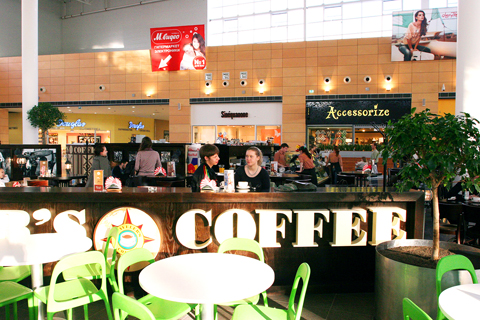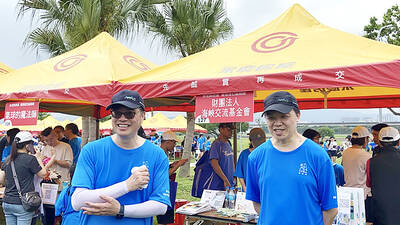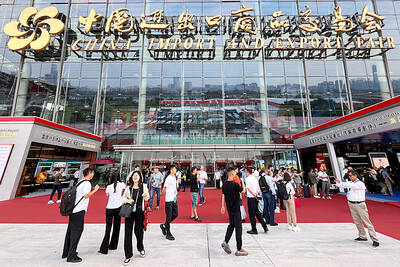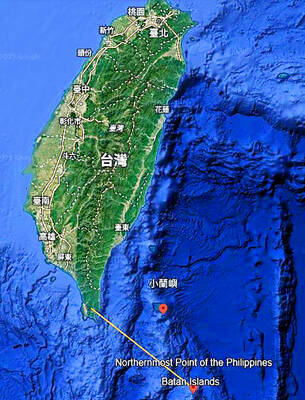In this region of Siberia, long synonymous with gulags and hardship, shoppers mobbed an Ikea store last winter with the vigor of a miners’ riot.
They loaded their outsize yellow shopping carts with clothes, housewares, appliances and small furniture.
The store and the surrounding Mega mall, opened last year on a bluff beside the Ob River, are expecting 12 million visitors this year — bursting with pent-up consumerism and oil rubles, unbothered by the economic uncertainty roiling much of the rest of the world.

PHOTO: NY TIMES NEWS SERVICE
Siberia, where Russians waited in long lines to buy food with ration cards not long ago, is the improbable epicenter of a huge mall boom. As retail businesses shrink in the US, provincial Russian towns like this one have become targets of retailers and shopping center developers from around the world. Malls in this area are even poaching managers from as far away as California.
Across the great expanse of Russia — on plots cleared of birch groves and decrepit factories, on the territory of old airports and collective farms — big-box stores are rising at a rate of several a month. Russia is projected to open twice as much mall space as any other European country this year, and Europe will open more shopping centers this year than ever.
Consumer culture
All that retail space is spawning a consumer culture in industrial towns that once had little of either.
“Your eyes open wide, there is so much to buy,” Tatyana Salamatina, a retired engineer at one of the city’s military factories, said in the food court of the Mega mall.
“You should carry a basket,” instead of pushing a cart, she advised, because “then you know by the weight when you have too much.”
To be sure, malls are nothing new in Moscow, where money from oil and other industries has always pooled. Indeed, in Moscow and the surrounding region, 38 malls are scheduled to open before 2010.
What is new is the dispersion of wealth in the Russian provinces that have, for centuries, been poor.
The proliferation of malls in Siberia is transforming the drab gray landscape on the outskirts of these cities into a tableau of Day-Glo green and purple outlets and providing a slim ray of hope to retailers whose business is lagging elsewhere.
Russian retailing has become such an alluring business that Ernst & Young and KPMG highlighted the sector last month at an investor road show in London.
In a sign of how trickle-down petroleum money appeals to retailers, at a time of near-record oil prices, Russian developers were expected to open 4.6 million square meters of retail space in shopping centers in the second half of last year and this year, said Cushman & Wakefield, the real estate company.
That is more than double the new shopping center area planned in Poland, the European country with the second-largest pipeline of malls in development.
“You have this incredible purchasing power in these cities retailers want to tap into,” said Charles Slater, a partner working in the Russia office of Cushman & Wakefield, which advises mall developers headed to the Russian hinterlands. “There is a race for land.”
That is another reason sparsely built Siberia is so popular.
Developers are turning to the 12 provincial cities in Russia with populations of more than 1 million, islands of prosperity with population inflows from rural migration and rising purchasing power, ripe for malls.
This retail strategy is known here as the “millions” and is embraced by leading Western retailers, including Ikea and Auchan, the French food chain.
This approach has put Siberia, not a place often associated with shopping, on “the center of the radar screen” for mall developers, said Jeff Kershaw, a former manager of California malls, now a partner in Moscow with the real estate company CB Richard Ellis.
For Wal-Mart, the appeal of expanding into frontier markets, like Siberia, is obvious. Its international sales from stores in 14 countries outside the US grew 17 percent last year, compared with 6 percent domestically.
Competition
Russia, ever competitive with the US, is also neck-and-neck in a new measure of competition: mall size.
The Belaya Dacha Mega mall outside Moscow, developed by Ikea like the mall in Novosibirsk, opened in 2004. It has 330,000m² of interior space, about the same size as the 325,000m² of interior space at the US’ largest mall, the Mall of America, outside Minneapolis. That does not include the Mall of America’s 2.8-hectare amusement park.
In some places in Russia, oversupply of mall space is already becoming a problem.
Kazan, a city on the Volga River, for example, has as much shopping space per capita as Paris, the Moscow office of CB Richard Ellis said.
Though pent-up demand for cars, cellphones and furniture is far from sated, this is still Siberia. The winters are long, the distances vast. And the history of the first Ikea store illustrates some enduring problems.
Dirk Hammerstein, manager of the store in Novosibirsk, said Russian customers, many living with several generations crammed into tiny apartments, made a run on sofa beds in December.
The truck convoys he dispatched for new sofa beds covered 3,300km each way to Ikea’s logistics center outside Moscow. He kept the store, the most remote in Ikea’s worldwide chain, in stock, barely.

SECURITY: As China is ‘reshaping’ Hong Kong’s population, Taiwan must raise the eligibility threshold for applications from Hong Kongers, Chiu Chui-cheng said When Hong Kong and Macau citizens apply for residency in Taiwan, it would be under a new category that includes a “national security observation period,” Mainland Affairs Council (MAC) Minister Chiu Chui-cheng (邱垂正) said yesterday. President William Lai (賴清德) on March 13 announced 17 strategies to counter China’s aggression toward Taiwan, including incorporating national security considerations into the review process for residency applications from Hong Kong and Macau citizens. The situation in Hong Kong is constantly changing, Chiu said to media yesterday on the sidelines of the Taipei Technology Run hosted by the Taipei Neihu Technology Park Development Association. With

CARROT AND STICK: While unrelenting in its military threats, China attracted nearly 40,000 Taiwanese to over 400 business events last year Nearly 40,000 Taiwanese last year joined industry events in China, such as conferences and trade fairs, supported by the Chinese government, a study showed yesterday, as Beijing ramps up a charm offensive toward Taipei alongside military pressure. China has long taken a carrot-and-stick approach to Taiwan, threatening it with the prospect of military action while reaching out to those it believes are amenable to Beijing’s point of view. Taiwanese security officials are wary of what they see as Beijing’s influence campaigns to sway public opinion after Taipei and Beijing gradually resumed travel links halted by the COVID-19 pandemic, but the scale of

A US Marine Corps regiment equipped with Naval Strike Missiles (NSM) is set to participate in the upcoming Balikatan 25 exercise in the Luzon Strait, marking the system’s first-ever deployment in the Philippines. US and Philippine officials have separately confirmed that the Navy Marine Expeditionary Ship Interdiction System (NMESIS) — the mobile launch platform for the Naval Strike Missile — would take part in the joint exercise. The missiles are being deployed to “a strategic first island chain chokepoint” in the waters between Taiwan proper and the Philippines, US-based Naval News reported. “The Luzon Strait and Bashi Channel represent a critical access

Pope Francis is be laid to rest on Saturday after lying in state for three days in St Peter’s Basilica, where the faithful are expected to flock to pay their respects to history’s first Latin American pontiff. The cardinals met yesterday in the Vatican’s synod hall to chart the next steps before a conclave begins to choose Francis’ successor, as condolences poured in from around the world. According to current norms, the conclave must begin between May 5 and 10. The cardinals set the funeral for Saturday at 10am in St Peter’s Square, to be celebrated by the dean of the College